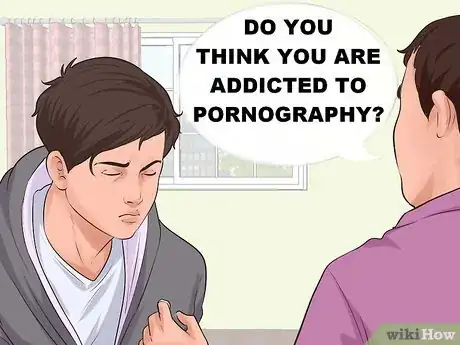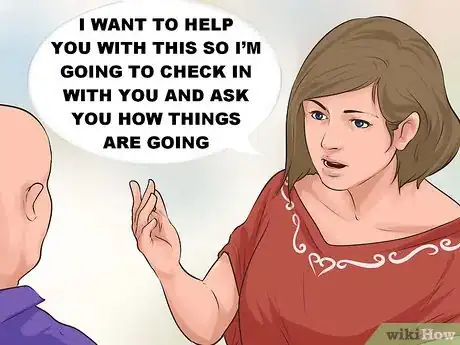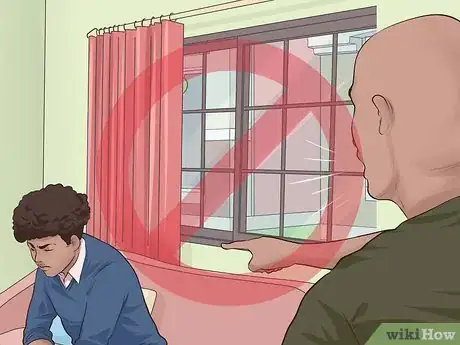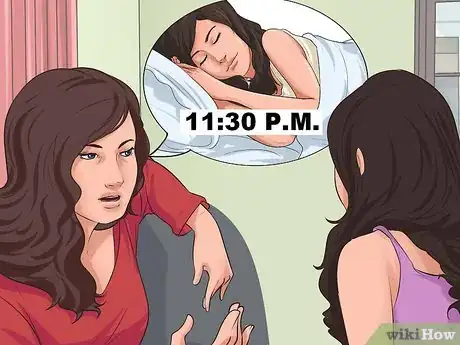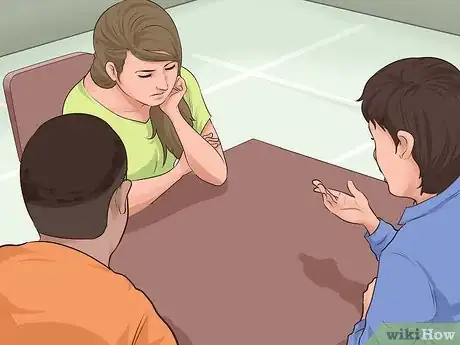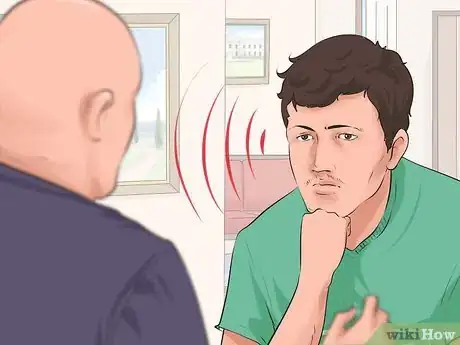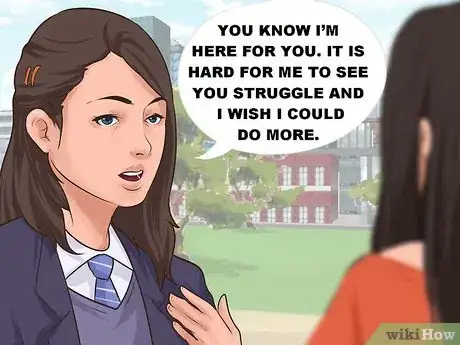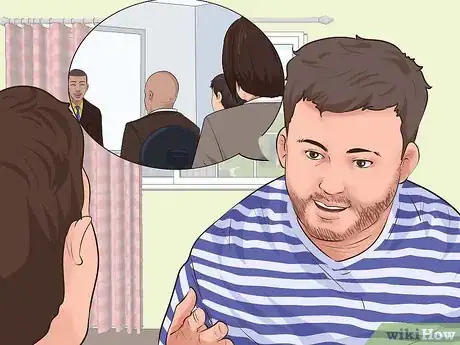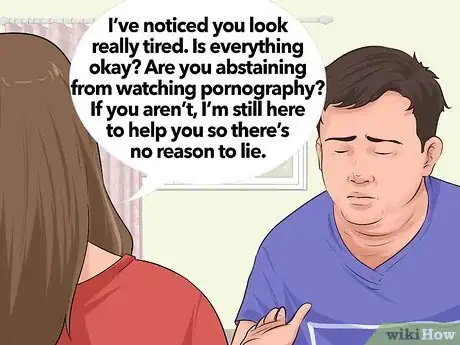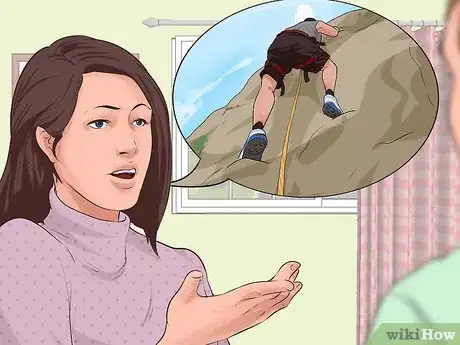This article was co-authored by Trudi Griffin, LPC, MS. Trudi Griffin is a Licensed Professional Counselor in Wisconsin specializing in Addictions and Mental Health. She provides therapy to people who struggle with addictions, mental health, and trauma in community health settings and private practice. She received her MS in Clinical Mental Health Counseling from Marquette University in 2011.
There are 22 references cited in this article, which can be found at the bottom of the page.
wikiHow marks an article as reader-approved once it receives enough positive feedback. This article received 12 testimonials and 87% of readers who voted found it helpful, earning it our reader-approved status.
This article has been viewed 651,075 times.
Helping others change a behavior can be both rewarding and very difficult. You run the risk of the person not wanting your help even though he needs it, or losing the relationship all together. If a friend or loved one’s pornography addiction absorbs excessive amounts of time, causes him to neglect his relationships, work, school and other important things in life, and he continues despite the negative consequences, then it is time to step in and help. Through using tactics to ignite action, shape new ways of thinking and foster a healthy life-balance, you can help someone manage a pornography addiction.
Steps
Igniting Action
-
1Talk about the problem to initiate action. It is likely a person with an addiction to pornography has kept it hidden from others. The process of talking allows someone to free himself from the lie of keeping secrets. Talking is extremely therapeutic and is used in many types of psychotherapy.[1]
- If the person tells you he has an addiction, then allow him to tell you his story. It is important for him to know that he is being heard.
- If you notice changes in the person’s behavior, then you can bring it up by saying something like, “I’ve noticed you are spending a lot more time online, and you look like something is bothering you. Do you want to talk about it?”
- Don’t be afraid to ask the tough, honest questions. Confronting difficult subject matter that might jeopardize a relationship is challenging. Deceit is at the root of addiction so you must tell the truth. You will need to ask direct, honest questions like, “Do you think you are addicted to pornography?”
-
2Be the accountability person. People tend to rise to a challenge when they know someone is interested in the outcome. There is a tendency to believe in yourself and your abilities when you can tell someone about your accomplishments. Accountability increases results and effectiveness.[2] You can be the person who asks to be updated, shows an interest in the person’s success, and will call a person out if he is not living up to expectations. It will help the person attach to a process that will help end unhealthy behaviors.
- You can help the person be accountable by saying something like, “I want to help you with this so I’m going to check in with you and ask you how things are going.”
- Offer to monitor the person’s computer activity by checking search histories on a daily or weekly basis. You must secure the person’s commitment to not delete his own search histories.
Advertisement -
3Avoid additional shame and guilt. An addiction to pornography carries its own sense of shame in most cultures. If a person is trying to change his behavior, additional shame and guilt is not helpful to the process. Help the person find other things that motivate positive change, rather than ridiculing negative behaviors.
- Encourage a healthy sense of right and wrong when necessary. You can do this by explaining to him that he needs to view himself separate from his behaviors. He is not a bad person, but his behaviors cause harm and must change.[3]
- If the addiction has caused harm to his relationships, you can say, “Your relationships are going to be so much better once you change your behavior. Life is going to be easier for you. It might not seem like it at first, but it will.”
- In contrast, a shame and guilt-filled statement would be to say “Don’t you want to stop messing up your relationships? I don’t know why you would want keep doing that. It doesn’t make any sense and it is so hurtful to everyone.”
-
4Help him develop a self-monitoring system.[4] Ending an old behavior involves learning a new set of behaviors. The goal of ending an addiction to pornography is to find alternate ways to manage and cope with negative feelings. A structured approach is always an effective way to manage behavior change.
- Identify the target behavior. Through discussion, identify the behaviors the person would like to change. For example, if the person stays up until 3:00 a.m. watching pornography and misses class or work in the morning, then he will need to change his sleeping schedule. A goal could be: Go to bed no later than 11:30 p.m. on weeknights.
- Help him select/design a system to monitor and change his behavior. This may include: setting schedules for limited time using the computer; scheduling time to do outdoor activities; requiring an hour per day writing about his feelings in a journal.
- If he is depressed, anxious, stressed or suffering from low self-esteem introduce relaxation techniques like yoga, meditation, and breathing exercises that have all been successful in treating these afflictions. [5]
- Choose ways to reinforce positive thoughts and behaviors. If he enjoys going to the movies or sporting events, these can serve as a rewards if he meets daily or weekly goals. This will help build self-esteem and his belief in himself.
- Fade your involvement as improvements happen. As he accumulates longer and longer periods of positive behavior you can slowly step back your involvement.
-
5Get him physically active. Provide healthy distractions to pull the person away from the computer. The goal is to help the person get physically active to build an interest in feeling the health benefits of physical activity. If he feels better he is more likely to stay positive and motivated to change.
- Suggest things like walking, running, hiking and weight lifting. These activities help the brain release endorphins, which increase feelings of pleasure and lessen pain.[6]
- Also, you could suggest that he take a dance class. Learning new dance steps requires his full attention, which allows him to take a mental break from his addiction.[7]
-
6Explore new interests. Having an addiction occupies most of the person’s time and pushes him away from pursuing his interests. It robs him of experiencing things that he enjoys, and things that he might enjoy if he had the time.
- Encourage him to explore his interests by answering the questions: What is missing in your life? Where would you travel if you could? If money had no implications, what would you do for a career?
- Perhaps playing the guitar has been an interest. Suggest that he take a class online or at a local music store.
- Encourage him to get involved in groups that share his non-pornography interests. These connections may lead to close friendships.[8] Take as much time away from the addiction as possible. If he spends most of his time on new activities, then there will be no time left for watching pornography.
-
7Suggest talking to a therapist. If his struggles are becoming more difficult and the self-help strategies are not making a big impact, then suggest that he see a therapist. He may be dealing with underlying anxiety, depression, and self-esteem issues that are too much to handle. A licensed therapist is trained to deal with these types of issues and can help the person. It is the goal of the therapist to provide a safe place to talk, express emotions and discuss the situation openly and honestly.[9]
- Reinforce the fact that it takes courage to make positive changes in his life. The therapist will echo your statements.
- Confirm that talking to a therapist is the next step toward getting the help he needs. You have been there for him to talk about his addiction, but now it is time to talk to a professional. You can tell him, “I will still be here for your, and you will have the therapist to talk to who will undoubtedly have better ways to help you.”
- Find a therapist who is a good fit. Ask a doctor, family member or trusted friend if they can recommend a therapist. There are professional therapists available in your local area who will help people deal with addictions.
- Look for a therapist who practices cognitive behavioral therapy.[10] This type of therapy is one commonly used to treat addiction and provides a step-by-step process designed to stop compulsive behavior. The therapist will help the person examine and dispel the negative thought patterns he has developed.
- You can suggest that the person attend a 12-step program designated for those people who suffer from sexually-related addictions. There are 12-step programs available worldwide. Contact a local chapter to obtain information on a meeting near you.
-
8Conduct an intervention.[11] Help comes in many forms, and sometimes a more focused approach is needed. An intervention is a planned confrontation by friends and family to address the person with an addiction. It is a hard decision to make, but one that is necessary if the addiction has spiraled out of control and the person’s life is in danger. Many people with an addiction are often in denial and unwilling to seek treatment. While an intervention will likely be overwhelming to the person, the intent is not to put the person on the defensive.
- Be aware that those who will participate in the intervention should be carefully chosen. The person’s loved ones can describe how the addiction to pornography is affecting them.
- There needs to be a plan in place to provide the person with treatment options. For example, there are inpatient programs, outpatient programs, and counseling is involved in all.
Shaping New Thoughts
-
1Provide emotional support. If the person has been open with you about his addiction you must focus on being supportive rather than negative. It is difficult to admit you have a problem. If you want to help you need to demonstrate that you can be trusted and will not make fun of the person. A good support system will help the person experience less stress.[12]
- It takes courage to admit you have a problem, so you can say something like, “First of all, thank you for telling me. I know that takes a lot of courage to do that. I’m here for you in any way I can help.”
-
2Show empathy. Being listened to and understood are key components to personal growth.[13] The emotional experience of dealing with a pornography addiction will force a person to grow, which may be painful. You can help ease the person's pain by actively listening.
- Put yourself in the person’s shoes. Learn to be compassionate and accepting rather than judging the person. Find resources that can teach you about being compassionate.[14] It might be difficult to understand, but you can always try.
- Treat the person like you would like to be treated. You have probably experienced struggles in your life and know what was helpful to you, and what wasn’t.
-
3Help him identify his emotional issues. When people experience unpleasant thoughts and feelings they may turn to viewing pornography as a way to manage those feelings. Pornography captures a person’s attention and pushes feelings of anxiety, depression, boredom, loneliness and stress away. Unfortunately, this is only a temporary solution and does nothing to create long-term effective ways of dealing with those feelings.
- Help the person determine if he has feelings of depression. There are online screening questionnaires that can help with the process.[15] He may have been depressed before delving into pornography, or he could be depressed because of his addiction to pornography. You can ask him, “Are there some things that you’re depressed about?”
- You can use the same type of question to address anxiety, loneliness, boredom and other emotions he may be trying to manage.
- Cybersex or pornography addiction involves compulsive behaviors. Unique challenges exist because the person can remain relatively anonymous, which allows him to continue the behavior. Additionally, unlimited access makes it that much harder to resist.[16]
- Suggest that he might be using pornography to push away his feelings rather than deal with them. Emphasize that you are there to help him and get him the help he needs. If that means putting a lock on his internet access, then do it.
-
4Celebrate the accomplishments. Changing behavior is difficult so if the person shows signs of improving you need to acknowledge his progress.[17] It may be small celebrations at first, building to larger ones as time goes by. If the person shares any news about the positive things he is doing, congratulate him.
- For example, he may tell you that he made it through an entire morning without looking at pornography. You could respond by saying, “That is awesome. You are really making progress. You really want to do this, don’t you? Keep going.”
-
5Realize you can only do so much to help. It is difficult to change your own behavior, but it is even harder to help someone change his behavior.[18] There are a lot of variables that you cannot control. Therefore, you will not always be able to help someone. The ability to let go of control and strictly be a guide and support for the person is where you will find success.
- You can provide consistency and reliability for the person. You are always there for him.
- There may be a time when you need to remind the person by saying, “You know I’m here for you. It is hard for me to see you struggle and I wish I could do more.” By saying things like this you will motivate him to try harder.
-
6Take care of your own health and well-being. When a person helps others she will experience health benefits including: feeling less depression, aches and pains, and you might even live longer than most people.[19] However, helping others can take a toll on you so take steps to stay physically and emotionally healthy. Focus on the following things to ensure a healthy emotional balance for yourself:
- Get the proper amount of sleep that you need to avoid getting exhausted.[20]
- Eat healthy food to maintain good health and energy and combat stress.[21] Include fruits and vegetables, lean proteins, complex carbohydrates and fiber. Avoid caffeine, sugar and foods high in saturated fats.
- Exercise regularly to help manage the stress you might be feeling.[22]
Creating Healthy Balance
-
1Continue your support. Be there for the person (text, call, see him). Remain positive in your interactions with the person; but be direct and honest and serious when necessary. He needs to know that there will be people to support him on the road to recovery, and that includes you.
- Be kind and understanding of the person’s struggle. Treat others as you would like to be treated.
-
2Encourage real life interactions. An addiction to pornography results in an imbalance in the amount of time spent online vs. time spent in real life. If a person hopes to have real, meaningful relationships with people, then he must engage in a balanced amount of human interactions.
- Invite him to attend gatherings with you where there will be new people. He may be uncomfortable in the beginning so be at his side to provide him the support he needs.
- Pornography has caused a distorted view of human sexual interaction. He will need to be educated on the realities of sexual relations. Do your best to provide reliable and honest resources to him.
-
3Plan and carry out healthy activities. Put yourself in charge of coordinating fun activities that will be beneficial to you and the other person. You deserve to have fun and if it can help the person expand their view of the world, all the better.
- Arrange sporting events, casual hang-out events, and vacations. If there is something you want to experience, encourage the person to join you.
-
4Be the voice of reason. Be the one who makes sure that common sense prevails. If the person tries to negotiate with you about complying with his commitment to not watch pornography, then confront him on his actions. He may think he can watch just a few minutes of it and be fine. You know that once he starts back up he won’t stop.
- Be the reminder of consequences. You will need to remind him about the dark place from which he came. Remind him that all the hard work he did will be eroded if he starts watching again. Approach the conversation in a matter-of-fact tone and explain, “This is not about shaming you or guilting you into something. This is about the reality that you were living and are living right now. You have a responsibility to yourself and the people who care about you.”
- Observe changes and discuss them. If you see changes in his behavior that lead you to believe there might have been a slip-up, then calmly confront the issue. You can say, “I’ve notices you look really tired. Is everything okay? Are you abstaining from watching pornography? If you aren’t, I’m still here to help you so there’s no reason to lie.”
-
5Understand there may be relapses.[23] You may find out by accident or the person may tell you. Either way, you must focus on helping the person forgive himself, regroup and continue on the path of abstaining from pornography. The more open and willing you are, the more likely he will continue to feel safe sharing his thoughts and feelings. This will prevent the person from creating secrets that can undermine his progress.
- Help the person manage the temptation to view pornography if a particularly difficult situation presents itself. Suggest alternate activities that will distract or preoccupy the person’s attention such as remote control airplane flying, or rock climbing. Get the person involved in something completely different.
- Encourage the person to forgive himself for any lapses in behavior. It is crucial for dealing with a setback. Do this by helping him focus on recommitting to his goals. You can tell him something like, “You may have slipped up, but what is important now is that you focus on small steps to get back on the program. Commit to the next hour that you will not do it. Build momentum with each hour you stick to your plan. You have to work your way back. Don’t give up on yourself.”
Warnings
- Addictions can ruin lives beyond repair.⧼thumbs_response⧽
References
- ↑ http://www.apa.org/helpcenter/understanding-psychotherapy.aspx
- ↑ http://www.forbes.com/sites/joefolkman/2014/11/14/how-do-you-score-the-8-great-accountability-skills-for-business-success/
- ↑ http://www.beyondintractability.org/essay/guilt-shame
- ↑ https://ici.umn.edu/products/impact/182/over6.html
- ↑ http://www.hsj.gr/medicine/stress-management-techniques-evidencebased-procedures-that-reduce-stress-and-promote-health.pdf
- ↑ http://www.ncbi.nlm.nih.gov/pmc/articles/PMC1402378/
- ↑ http://www.ncbi.nlm.nih.gov/pmc/articles/PMC1470658/
- ↑ http://www.helpguide.org/articles/relationships/how-to-make-friends.htm
- ↑ http://www.nhs.uk/conditions/stress-anxiety-depression/pages/benefits-of-talking-therapy.aspx
- ↑ http://www.helpguide.org/articles/anxiety/therapy-for-anxiety-disorders.htm
- ↑ http://www.mayoclinic.org/diseases-conditions/mental-illness/in-depth/intervention/art-20047451
- ↑ http://www.takingcharge.csh.umn.edu/explore-healing-practices/social-support
- ↑ http://www.simplypsychology.org/carl-rogers.html
- ↑ http://jme.bmj.com/content/9/4/189.abstract
- ↑ http://www.mentalhealthamerica.net/mental-health-screen/patient-health
- ↑ http://www.helpguide.org/articles/addiction/internet-and-computer-addiction.htm
- ↑ http://www.hindawi.com/journals/tswj/2012/809578/
- ↑ http://www.mentalhealthamerica.net/when-change-hard
- ↑ http://www.mentalhealthamerica.net/help-others
- ↑ http://www.nhlbi.nih.gov/health/health-topics/topics/sdd/why
- ↑ http://www.pcrm.org/health/health-topics/how-to-eat-right-to-reduce-stress
- ↑ http://www.ncbi.nlm.nih.gov/pmc/articles/PMC1402378/
- ↑ http://www.asam.org/for-the-public/definition-of-addiction
About This Article
Helping someone overcome a pornography addiction can be really difficult, but by offering emotional support and encouraging them to take up new, good habits, you’ll have a better chance of success. When you find out about the addiction, let the person know you’re there to help, since admitting to an addiction is a big step. You should also listen compassionately to how they talk about their problem, because you’ll only make it harder for them if you judge or try to shame them into action. A pornography addiction means the person is spending a lot of time alone online, so encourage them to get out and make new connections by inviting them to social gatherings or doing activities with them. Check in with the person regularly by text or email, since they’ll feel a greater responsibility to change their behavior if they feel accountable to someone else. For tips from our co-author on how to deal with a relapse by the addicted person, keep reading!
